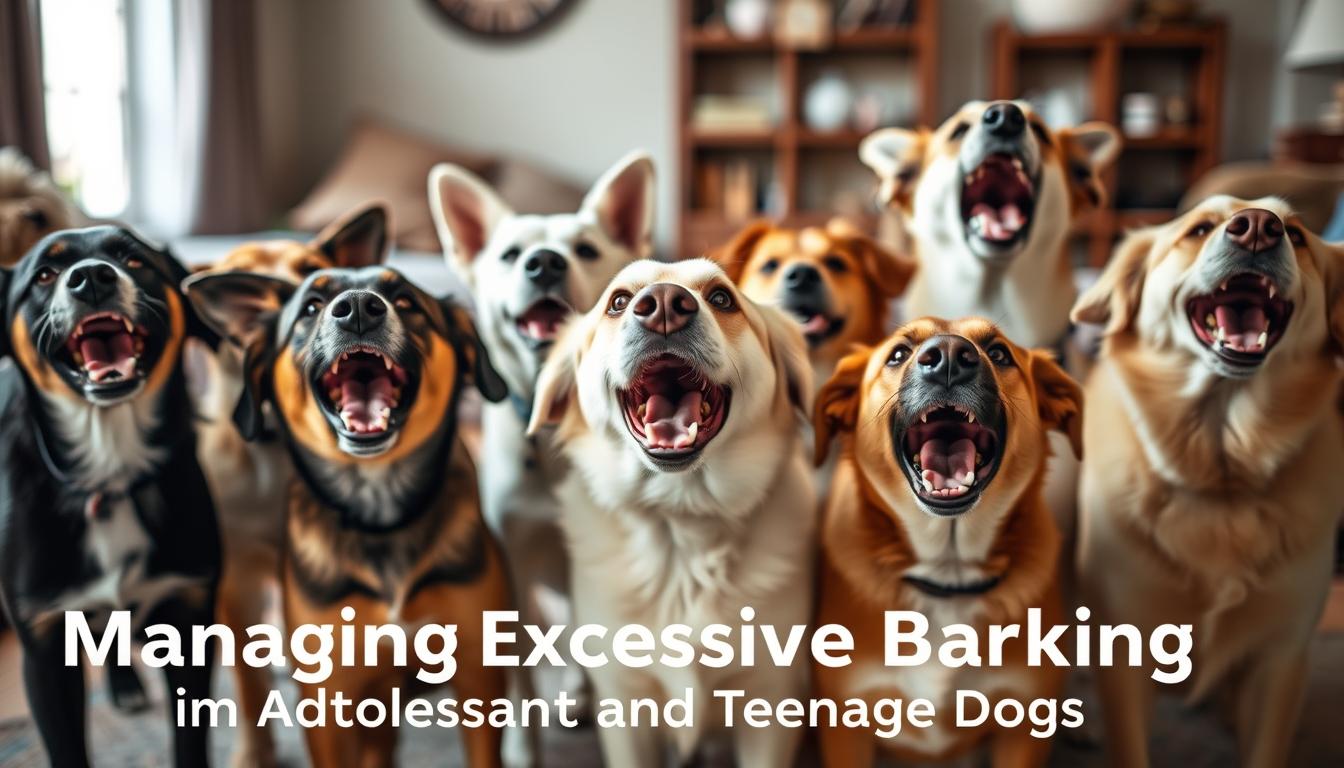As a dog owner, dealing with excessive barking can be really tough. It’s even harder during the tough teenage years. My 13-year-old dogs taught me that knowing how dogs grow is key to solving this problem.
Adolescence in dogs lasts from 6 months to 2 years. During this time, they have lots of youthful energy and crave attention. This often leads to too much barking. Knowing why they bark, like boredom or frustration, helps. Using dog training tips can change this behavior.
Keeping dogs mentally and physically active helps a lot. Consistent training also plays a big role. By setting rules and praising good behavior, we can lessen the barking.
Understanding Canine Adolescence
Canine adolescence is a key time in a dog’s life. It’s when they go through big physical and emotional changes. This stage usually lasts from 6 to 18 months, and it can be tough for both the dog and the owner.
Small vs. Large Breed Differences
Small and large breeds grow at different rates. Smaller breeds grow up faster than bigger ones. For example, small breed dogs might start their teenage phase earlier and end it sooner. Bigger breeds take longer to grow up.
When a puppy starts to act like a teenager, you’ll notice changes. They become more independent and test boundaries. They might also stop listening to commands they used to follow. It’s a time of exploration and learning, where they might chew, dig, or show other destructive behaviors because of their high energy and curiosity.
Regression in Training
Training can go backward during canine adolescence. Dogs may forget what they learned before. Consistency and patience are key during this time. The dog needs help remembering what they learned before.
Increased Vocalization Tendencies
Dogs bark more during this phase. They might bark because they’re excited, anxious, or trying to warn their owners. It’s important to understand why they bark more to deal with it.
Why Excessive Barking Increases During Adolescence
Adolescence in dogs brings many changes, with excessive barking being a big one. Dogs in this phase often try to push boundaries and challenge their owners.
This stage is marked by a strong urge to vocalize. Dogs use this to show excitement, anxiety, or defiance. Knowing this helps us tackle the problem.
The Connection Between Defiance and Vocalization
Defiance in young dogs shows up as excessive barking. It’s a way for them to show dominance or test limits. Understanding why they bark so much is crucial for fixing the issue.
Seeing the link between defiance and vocalization helps owners tackle the root of the problem. This way, we can manage the excessive barking in young dogs better.
Common Triggers for Barking in Adolescent Dogs
It’s important to know what makes adolescent dogs bark a lot. They bark because of things they see and hear around them.
Visitors coming home, delivery people at the door, and other animals outside are common reasons. Even things like people walking by or kids playing can make them bark.
To handle these issues, dog owners can take a few steps. For example, they can teach their dogs to stay quiet when visitors come. They can also get their dogs used to delivery people by practicing with them.
As an expert says, “Being consistent and patient is crucial when teaching adolescent dogs to control their barking.”
“The key to addressing barking is understanding what’s causing it and then taking steps to mitigate those causes.”
By figuring out and fixing the reasons for barking, owners can help their dogs bark less. This makes for a quieter home for everyone.
Breed-Specific Barking Tendencies
Different dog breeds bark in varying ways, shaped by their original purpose and genetics. For example, Beagles and Foxhounds bark a lot because they were bred to hunt. They alert and track by barking. In contrast, Basenjis are quiet because they were bred for silent hunting.
Breed-specific traits play a crucial role in determining barking behavior. For example:
- Guard breeds like German Shepherds and Rottweilers may bark more due to their protective instincts.
- Terrier breeds are known for their vocal nature, often barking at perceived threats or when excited.
- Companion breeds like Cavalier King Charles Spaniels may bark to seek attention or due to separation anxiety.
Knowing these breed-specific traits helps owners manage barking in adolescent dogs. Owners can adjust their training and interaction to reduce excessive barking by understanding their dog’s breed.
Differentiating Between Normal and Problematic Barking
It’s important for dog owners to know the difference between normal and problematic barking. Barking is how dogs communicate. But, too much or the wrong kind of barking can mean there’s a problem.
Alert Barking vs. Demand Barking
Alert barking happens when dogs hear something or see someone new. It’s a normal way for them to react. On the other hand, demand barking is when a dog wants attention or food. Knowing why a dog barks helps you know how to respond.
Anxiety-Based Vocalization
Anxiety-based vocalization shows that a dog is upset. This could be because they’re scared, anxious, or stressed. Finding out what’s causing their anxiety is key to stopping the barking.
Duration and Intensity Indicators
The duration and intensity of barking tell you if it’s normal or not. If a dog barks for a long time or very loudly, it might be a sign of a bigger issue.
Managing Excessive Barking in Adolescent and Teenage Dogs
The adolescent stage in dogs is crucial for developing good behavior. Family participation is key to curbing excessive barking. During this phase, dogs test boundaries and learn what is acceptable behavior.
Family Involvement in Training is vital because it ensures consistency in the commands and rules applied to the dog. When all family members are on the same page, it reinforces the training. This helps in managing excessive barking more effectively.
Family Involvement in Training
To achieve unified family involvement, it’s essential to educate all members about the training methods and strategies being used. This includes:
- Setting clear rules and boundaries
- Using consistent commands and hand signals
- Rewarding good behavior and ignoring or redirecting bad behavior
Consistency is crucial in dog training. When family members consistently apply the training rules, the dog is more likely to understand what is expected. This consistency helps in reducing confusion and anxiety in dogs, which are common triggers for excessive barking.

Involve the whole family in training activities to strengthen the bond between the dog and family members. It also ensures that the dog responds to commands from everyone, not just one person.
By working together as a team, families can effectively manage excessive barking in their adolescent and teenage dogs. This creates a more harmonious home environment.
Physical Exercise Solutions to Reduce Barking
To tackle excessive barking, a strong physical exercise plan is key for young dogs. Regular activity boosts their health and cuts down on barking caused by too much energy.
Structured Play Sessions
Structured play sessions are a great way to keep your dog busy. Activities like fetch, agility training, or obedience exercises help burn off energy. This way, your dog won’t bark as much.
Safe Off-Leash Opportunities
Offering safe off-leash opportunities lets your dog explore and exercise freely. This is vital for their growth and less barking. Make sure these spots are secure and fenced to avoid dangers.
Adding structured play and safe off-leash activities to your dog’s routine helps a lot. These exercises not only solve the barking problem but also improve your dog’s health and growth.
Mental Stimulation Techniques to Prevent Boredom Barking
One of the best ways to stop boredom barking is through mental games. As dogs grow up, they need activities that challenge their minds and keep them busy.
Mental games are key for stopping boredom barking in young dogs. Using food-based enrichment and rotating toys can keep dogs interested and active.
Food-Based Enrichment Options
Food-based enrichment uses a dog’s meals or treats to challenge their minds. This can be done through:
- Interactive puzzle toys filled with kibble or treats
- Hide-and-seek games where treats are hidden around the house or yard
- Slow-feeder bowls that make mealtime more challenging and fun
These activities not only cut down on boredom barking but also give dogs a sense of achievement and happiness.
Rotating Toys to Maintain Interest
Rotating toys is another great way to keep a dog’s interest and stop boredom. By changing the toys your dog has, you can keep their world exciting and new.
Tips for rotating toys:
- Bring in new toys every few days to keep things fresh
- Store toys away and bring them back out to make them seem new again
- Use a mix of toys, like squeaky toys, chew toys, and interactive ones, to meet different interests
By adding these mental games to your dog’s daily life, you can greatly reduce boredom barking. This makes your dog’s life more fun and rewarding.
Training Methods to Address Excessive Barking
To tackle excessive barking, a structured training approach is key. Effective methods can greatly reduce barking in young dogs.
Reward Timing and Consistency
Reward timing is crucial in dog training. Rewards should be given right after the desired behavior. This reinforces positive actions. Consistency in rewarding is also vital; it helps the dog understand what’s encouraged.
Setting clear rules and boundaries is part of consistent training. Everyone in the family should agree on what behaviors are okay. This avoids confusing the dog.
Step-by-Step Training Process
A step-by-step training process shapes the dog’s behavior gradually. Begin with simple commands and move to more complex ones. Each step must be mastered before advancing.
For instance, teaching a dog to “quiet” starts with getting it to bark. Then, reward it for stopping. Gradually increase the quiet time before rewarding.
Creating Positive Associations
Creating positive associations links triggers that cause barking (like strangers or noises) with positive outcomes (like treats or praise). This reduces the dog’s stress and barking over time.

By using these training methods, dog owners can manage and reduce excessive barking. It’s all about being consistent, patient, and positive in training.
Managing Barking When You’re Away from Home
Managing your dog’s barking when you’re not there is a big challenge. Dogs bark for many reasons, like feeling left out or being bored. It’s important to find ways to solve these problems.
Safe Containment Options
Creating a safe space is crucial to cut down on barking. Safe containment options, like crate training, stop destructive behavior. They also reduce barking caused by outside noises. For more tips on managing barking in different homes, check out this resource on puppy barking in apartments.
Background Noise and Comfort Items
Background noise, like white noise machines or calming music, can hide outside sounds that make dogs bark. Also, giving comfort items, like a favorite toy or blanket, can calm your dog. This can help lower anxiety barking.
Smart devices are great for managing your dog’s barking when you’re not there. Devices that let you interact remotely, like treat-dispensing cameras, can keep your dog busy. They also let you check on and stop barking right away.
By using these methods, dog owners can greatly reduce barking when they’re away. This makes life better for both the dog and the neighbors.
When to Seek Professional Help
If your dog’s barking doesn’t stop, it’s time to get professional help. Knowing the difference between trainers and behaviorists is key. They offer different types of training to solve your dog’s barking problem.
Trainers vs. Behaviorists
Dog trainers and behaviorists help dog owners with their pets’ behavior. A dog trainer teaches obedience and basic commands. A behaviorist looks into the psychological reasons behind a dog’s behavior, like excessive barking.
Choosing professional help means deciding between group classes and private sessions. Group classes are good for socialization and are cheaper. But, private sessions give your dog one-on-one attention, which might solve barking issues better.
Choosing between trainers and behaviorists, or group classes and private sessions, depends on your dog’s needs. It also depends on how serious the barking problem is.
Conclusion
Managing excessive barking in young dogs needs a full plan. This plan should tackle the main reasons for the barking.
Knowing how dogs grow and what makes them bark helps owners. They can then use good training and ways to manage the barking.
Exercise, mental games, and training are key for young dogs. They help dogs get through tough times in their growth.
Being consistent and patient is very important. If the barking doesn’t stop, getting help from a pro is a good idea.
With the right steps and support, owners can teach their teenage dogs good habits. This also makes their bond stronger.
Controlling excessive barking is vital for a peaceful home. It ensures a happy and healthy life for dogs and their owners.






